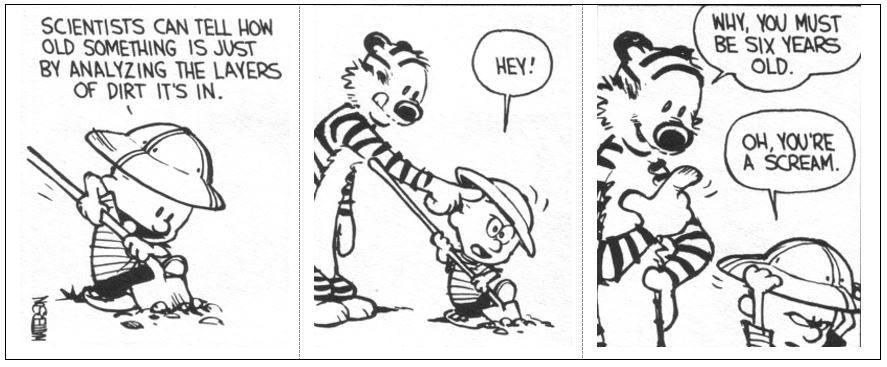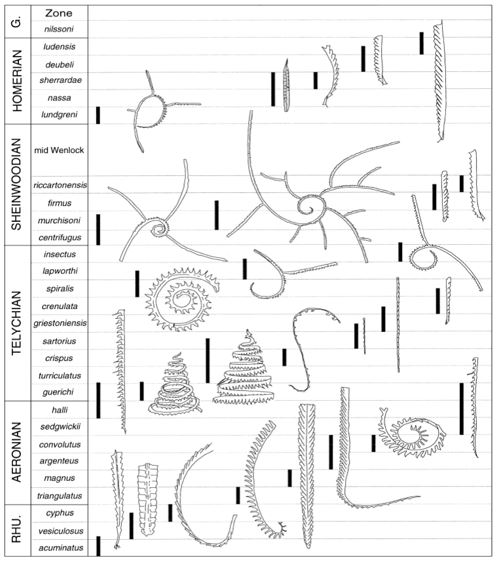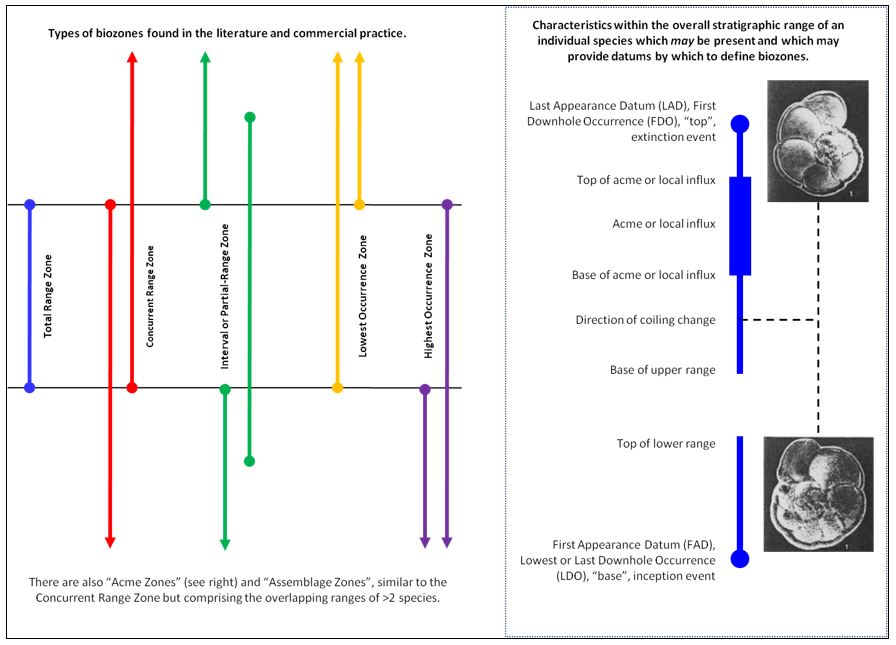Table of Contents
Biostratigraphy and Biozonation
Biostratigraphy has a fairly simple premise…

It is less amusingly defined as…
“The separation and differentiation of rock units on the basis of the description and study of the fossils they contain” Glossary of Geology. Bates & Jackson. 1980
What “makes biostratigraphy work” is evolution. Species evolve into new forms and have a measurable period of existence before becoming extinct. Each species has a discreet inception and extinction in geologic time. Therefore, periods of geologic time may be characterised by the presence (or absence) of a species, the co-existence of several species or their abundance (see below).

Evolution drives the appearance of new species and the subsequent extinction of those species. These are the stratigraphic ranges of many types of Graptolites – an extinct group of Paleozoic colonial organisms.
Biozonation
It is very common to find mention of “biozones” or “zones” in the geological literature, but what are they?
A “biozone” (see figure below) is an interval of rock between two successive biostratigraphic events in the rock record. Ideally, such events should be relatively closely spaced (i.e. not too far apart in geologic time), easily recognisable and commonly found in rock sections around the world.

A properly defined biozone is independent of lithology type and sedimentation rate.
In the literature most formally-described biozones are defined by the successive first appearances of new species in the fossil record (i.e., the “base” of a fossil’s total stratigraphic range). Why exactly this is, is uncertain, although it probably seems logical given that the passage of geologic time moves “upwards” through a rock succession.
However, in industry, due to the effects of a process known as “caving” during the drilling of boreholes, it is common to rely more on the successive last appearances (i.e. the “tops” or “extinction events”) of species in the fossil record. This is because in industry – given that the majority of data sets are collected from samples which come out of boreholes – a “driller’s perspective” is used which follows the path of the drill itself i.e., downwards through the geological succession and therefore going “backwards” in time.
It is not clear if one particular method is advantageous over the other and it will be shown below that there is no reason why it should be thought that first appearances are particularly more synchronous or widespread than last appearances.
Other features, characteristic of the stratigraphic range of an individual species, may also be used as biostratigraphic marker events such as…
- Species Top (extinction horizon, last appearance datum (LAD), first downhole occurrence (FDO)
- Marked Abundance Change (abundance peak, acme, increase, pulse, influx, flood)
- Coiling Change (some species exhibit a consistent change in coiling direction at more-or-less fixed stratigraphic levels)
- Preservation Character Change (mainly used only at local levels)
- Second Occurrence (some species exhibit the “Lazarus Effect” and appear to have a known and consistent “gap” in their stratigraphic distribution)
- Species base (inception horizon, first appearance datum (FAD), last downhole occurrence (LDO)
Some common misconceptions about biozones are:
They are all the same duration. In the figure showing graptolite ranges above, each biozone is of the same thickness giving the impression they are of equal duration. This is simply a convenient way of drawing this type of diagram. Biozones are of varying duration as inceptions and extinctions of species are not governed by some mystical clock and species can exist on Earth for hugely variable periods of time.
Biozones are named after the fossil species that ranges within them. A biozone is often (but not always) named after a particularly characteristic fossil species that occurs within it, but it is not necessarily defined by the total stratigraphic range, or the top, or the base of that species. In a recent evaluation by Neftex/Landmark scientists it was found that more than half of named standard biozones were named after species that ranged above and/or below the zonal limits. In order to avoid confusion in this way, many biozones are given coded sequence numbers (N5, N6, N7… etc.) rather than zonal names.
When is a biozone not a biozone? Until very recently, many of the standard Ammonite zones used extensively in Mesozoic stratigraphy were not true biozones at all but merely labels (named after characteristic ammonite species) that were found in individual rock layers. While this sounds like the definition of a biozone it was in fact merely a way of labelling intervals of rock which were otherwise below the resolution of normal chronostratigraphic stage and/or substage names i.e., these were chronostratigraphic units not biostratigraphic zones and therefore subject to the same interpretational errors already discussed above in Stratigraphy. For example, the rock interval defined as the “Parahoplites melchioris ammonite zone”, at the top of the Gargasian substage of the lower late Aptian, was a series of rocks where somewhere in that interval (not necessarily at the base or at the top) some specimens of Parahoplites melchioris were found and used to give a label to that rock series. Fortunately this anomaly is being addressed and at time of writing, proper biozone definitions for many Mesozoic intervals have been and are being constructed.
Are “Horizons” biozones? In the literature there are sometimes references to “horizons” named after fossil species. Again, these tend to occur more frequently in Mesozoic sections and concern ammonites. A “horizon” in this sense is a single layer, along which a particular species has been recorded. Logically, it is a two-dimensional surface lacking the dimension of time and therefore not a biozone. However, it may prove useful for correlation purposes although of course there is no guarantee that a “horizon” observed in one place was laid down at the same time as the same “horizon”” in another. This is because the species will have logically existed for at least a definite time “duration” in its existence on Earth. Ammonites however, are generally comprised of short-lived species and in the general sense, two separate “horizons” may be correlatable within those limits of resolution.

Types of Biozones and characteristics of species ranges that help define them. “Highest Occurrence Zones” are often used in industry because using extinction events or “tops” to define biozones mitigates against some of the effects of sample contamination due to “caving”.

This diagram illustrates some of the natural factors controlling distribution that can have a significant effect on how a species (and therefore its fossil remains) can be distributed in time and space in rocks during the lifetime of the species itself. Other factors after death will also come into play (such as dissolution or weathering) which determine whether the fossil remains are ultimately preserved or not. Consequently we can never be 100% certain if (for example) the highest occurrence of a fossil species in an individual rock section represents its final “true” extinction, or just a “local” extinction that occurred earlier.
